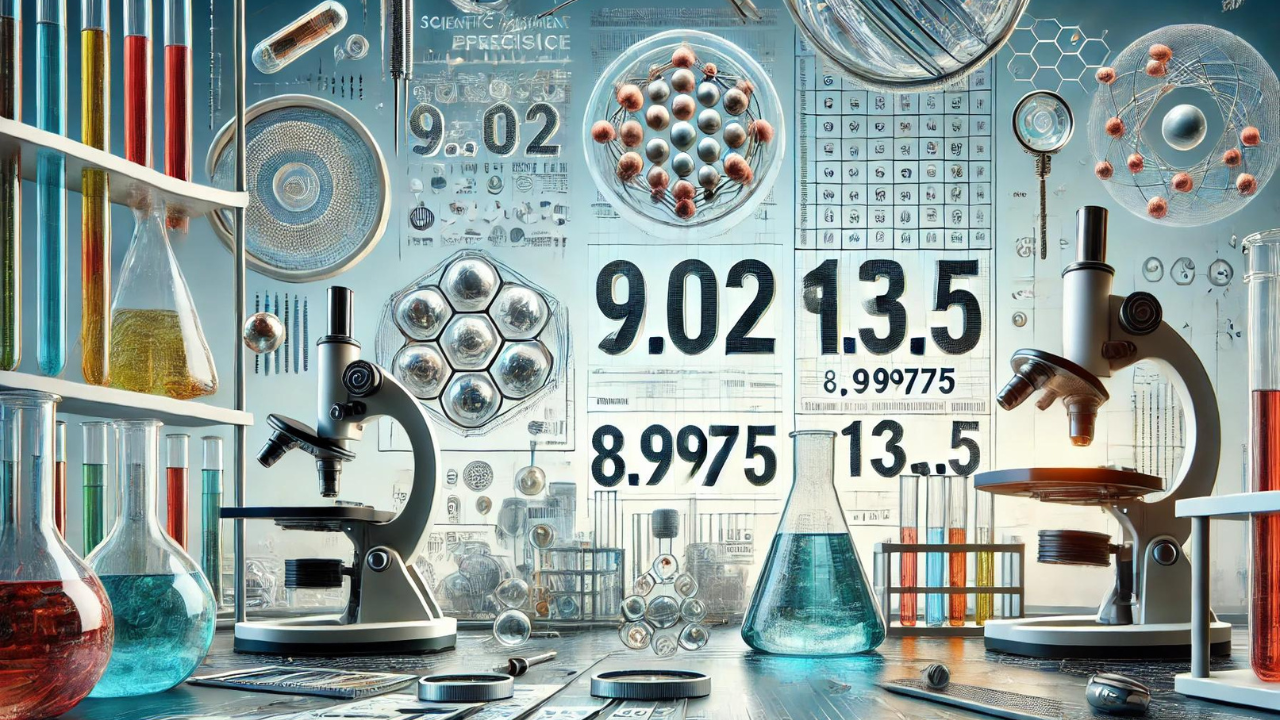Introduction
In scientific research, precision and accuracy are paramount. The numbers “9.02 8.9975 13.5” are not just arbitrary figures; they represent critical data points that have significant implications in various scientific measurements. This article explores the importance of these specific numbers, examining their roles across different scientific disciplines and their contributions to broader understanding and technological advancements.
Understanding the Numbers
The numbers “9.02 8.9975 13.5” are integral in scientific studies where each value could signify distinct or related measurements critical in their respective fields:
- 9.02: This number, often seen in chemistry, might indicate a pH level essential for specific biological processes or chemical reactions.
- 8.9975: This precise value could relate to measurements of gravitational pull or magnetic fields, essential in theoretical and applied physics.
- 13.5: This number could denote an energy level in quantum mechanics or a critical wavelength in optical sciences.
Applications in Various Scientific Fields
- ChemistryThe precise measurement of 9.02 could be critical for determining the exact concentration of hydrogen ions in a solution, vital for experiments involving acid-base titrations or enzymatic activity in biochemistry.
- PhysicsThe value 8.9975 might be crucial in calibrating instruments used to measure physical constants or in setting up experimental environments where even a slight deviation could lead to significant errors.
- BiologyA measure 13.5 could represent a biological marker or threshold necessary to understand cellular processes or disease mechanisms in medical research.
The Role in Experimental Design and Analysis
The reliability of scientific experiments largely depends on the accuracy of critical numbers like “9.02 8.9975 13.5”. These numbers help establish standards, calibrate equipment, and ensure consistency and reproducibility in scientific research.
Technological Implications
The implications of accurately measuring “9.02 8.9975 13.5” extend into technological innovation:
- Material Science: Innovations often require understanding properties at these measurements to develop new materials with desired thermal, electrical, or mechanical properties.
- Environmental Monitoring: Accurate data is crucial in tracking ecological changes, where these numbers could represent key indicators in climate models or pollution levels.
- Healthcare: In medicine, these measurements could be critical in the design and use of medical devices or in the diagnostic process, where precision is essential for effective treatment.
Challenges in Measurement Accuracy
Maintaining the accuracy of measurements like “9.02 8.9975 13.5” involves overcoming several challenges:
- Instrumentation Calibration: Regular calibration is required to maintain the accuracy of measurements.
- Environmental Variables: Temperature, pressure, and humidity can alter readings, necessitating controlled experimental conditions.
- Operator Skill: The precision of these measurements also depends on the skill and attentiveness of the personnel performing the experiments.
Future Prospects
As technology advances, the significance of “9.02 8.9975 13.5” in scientific measurements will continue to grow. Enhanced measurement techniques and more sophisticated instruments will likely reveal new applications and deepen our understanding of these critical numbers.
FAQS
What do the numbers 9.02 8.9975 13.5 represent in scientific contexts?
- These numbers are critical data points used in various scientific fields. For example, 9.02 might indicate a pH level in chemistry, 8.9975 could be associated with physical constants like gravitational force in physics, and 13.5 might denote an energy level or wavelength critical in fields like quantum mechanics or optics.
Why are precise measurements like 9.02 8.9975 13.5, and 13.5 crucial in scientific research?
- Precise measurements are fundamental for ensuring the accuracy and reliability of scientific experiments. They help set standards, calibrate instruments, and provide consistent and reproducible results, essential for validating theories and developing new technologies.
How do the numbers 9.02, 8.9975, and 13.5 impact technological advancements?
- These measurements are vital to developing new materials, enhancing environmental monitoring techniques, and improving medical technologies. Accurate data at these points allows for optimised materials science properties, precise ecological assessments, and adequate medical diagnostics and treatments.
What are the challenges in maintaining the accuracy of measurements like 9.02, 8.9975, and 13.5?
- Challenges include the need for regular instrument calibration, managing environmental factors that can affect measurements, and the requirement for skilled operation and meticulous handling in experimental setups to avoid errors.
What prospects are linked to enhancing the precision of measurements such as 9.02, 8.9975, and 13.5?
- Enhancing the precision of these measurements will likely lead to breakthroughs in scientific understanding and technology. It will enable researchers to explore new phenomena more accurately, contribute to developing innovative materials and technologies, and offer more detailed and precise environmental and health diagnostics.
Conclusion
9.02 8.9975 13.5 are foundational in pursuing scientific knowledge. Their precise measurement is crucial across various science and technology domains, influencing research outcomes and innovations. As we advance in our scientific endeavours, the role of these critical numbers will undoubtedly expand, continuing to shape the landscape of scientific discovery and technological progress.
You May Also Read: https://usadigitaltime.com/inkapenis/
